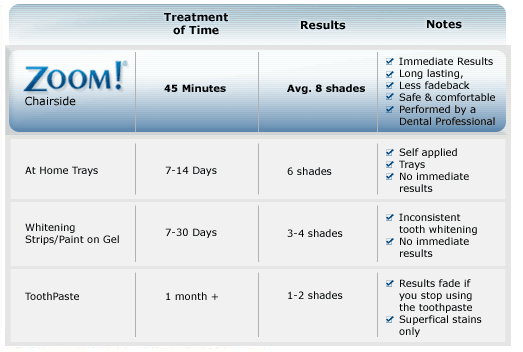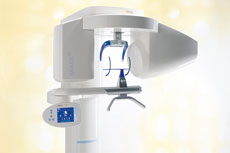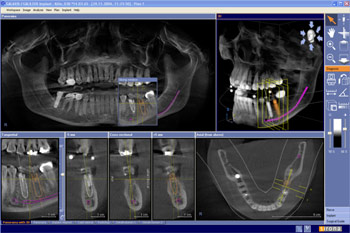|
|
What to expect at your visit! Dental Exam "Hi!" Most likely I will be the dental assistant who will greet you at the time of your appointment. I will take you to a hygiene room where I will be asking you a series of questions regarding your dental hygiene." A comprehensive
dental exam will be performed by the doctors at your initial dental visit. This dental exam will include the following:
■Diagnostic x-rays: Essential for detection of decay, tumors, cysts, and bone loss. X-rays also help determine tooth
and root positioning.
■Oral cancer screening: The Drs. perform a manual check of the face, neck, lips, tongue, throat, tissues, and gums
for any signs of oral cancer. Ask them about our new program called "Peace of Mind for Life."
■Gum disease evaluation: The hygienist will take specific measurements around your teeth to check the gums
and bone around the teeth for any signs of periodontal disease.
■Examination of tooth decay: All tooth surfaces will be checked for decay with special dental instruments.
■Examination of existing restorations:
Check existing fillings, crowns, etc. ■Examination of the TMJ and bite.
Professional Dental Cleaning
Our registered dental hygienists will perform a professional dental cleaning, which will include a dental exam and
the following:
■Tartar removal: Tartar is hardened plaque that has been left on the tooth for some time and is now firmly attached
to the tooth surface. Tartar forms above and below the gum line, and can only be removed with special dental instruments.
■Plaque removal: Plaque is a sticky, almost invisible
film that consists of live bacteria, food debris and saliva that forms on the teeth. The live bacteria produce toxins
that infect the gums. If left untreated, the infection could lead to periodontal disease!
■Teeth polishing: Remove stains and plaque that is not otherwise
removed during tooth brushing and scaling.
Gum disease (also called periodontal disease) is an infection of the tissues that support your teeth. It is a major
cause of tooth loss in adults. You may not know you have it, because periodontal disease is usually painless. At regular checkups,
the dentist will measure the depth of the shallow v-shaped crevice (called a sulcus) between your tooth and gums to identify
whether you have gum disease.
Gum disease is caused by plaque, a sticky film of bacteria that constantly forms on the teeth. These bacteria create
toxins that can damage the gums.
Periodontal diseases attack just below the gum line in the sulcus, where they cause the attachment of the tooth and
supporting tissues to break down. As the tissues are damaged, the sulcus develops into a pocket; generally, the more severe
the disease, the greater the depth of the pocket.
Periodontal disease is classified according to the severity of the disease. The two major stages are gingivitis and
periodontitis. Gingivitis
In the early stage of gum disease, called gingivitis, the gums become red, swollen and bleed easily. At this stage,
the disease is still reversible and can usually be eliminated by daily brushing and flossing. Periodontitis
In the more advanced stages of gum disease, called periodontitis, the gums and bone that support the teeth become seriously
damaged. Whereas healthy gums and bone anchor teeth firmly in place, infected gums can cause teeth to become loose, fall out,
or have to be removed by a dentist.
Some factors increase the risk of developing periodontal disease:Tobacco smoking or chewing System-wide diseases such
as diabetes Some types of medication such as steroids, some types of anti-epilepsy drugs, cancer therapy drugs, some calcium
channel blockers, and oral contraceptives Fillings that have become defective Bridges that no longer fit properly Crooked
teeth Pregnancy
If you notice any of the following signs of gum disease, see the doctor immediately:Gums that bleed easily Red, swollen,
tender gums Gums that have pulled away from the teeth Persistent bad breath or bad taste Pus between your teeth and gums Permanent
teeth that are loose or separating Any change in the way your teeth fit together when you bite Any change in the fit of partial
dentures
It is possible to have periodontal disease and have no warning signs, which is one reason why regular dental checkups
and periodontal examinations are very important. Treatment methods depend on the type of disease and how far the condition
has progressed. Good oral hygiene at home is essential to keep periodontal disease from becoming more serious or recurring. You don't have to lose teeth to periodontal disease. Brush regularly, clean between your teeth, eat a balanced diet, and schedule regular dental visits for a lifetime of healthy smiles. One of the exciting procedures we have is called Zoom. The following chart shows you the results typical from this procedure.
GALILEOS 3D Dental X-Rays
X-rays are essential preventative and diagnostic tools that provide valuable information not visible during visual
dental exam. Our Dentists use this information to design a more accurate treatment plan. Without x-rays, problem areas could
easily go undetected.
Dental x-rays may reveal:
■Decay between teeth
■Abscesses or cysts
■Bone loss
■Cancerous and non-cancerous tumors
■Developmental abnormalities Advantages of Digital Radiography The advantages
of digital x-rays when compared with film-based machines include:
■90% less radiation exposure than traditional x-rays
■Ability to refine image quality for more precision
■Instant viewing on computer screen (no waiting for films to develop)
■Environmentally friendly (no toxic chemicals)
Best of all, it’s easy for you to see what they see. You will have the ability to view your digital x-rays on
our 36" screen along with the Doctors. They will share their findings with you. This will give you a clear picture of your
dental condition and help you make informed choices about your treatment.
|



